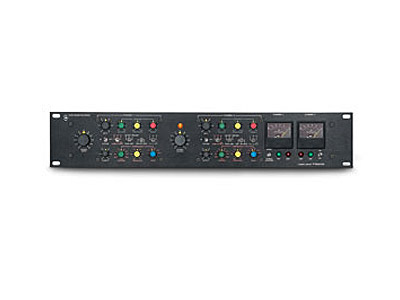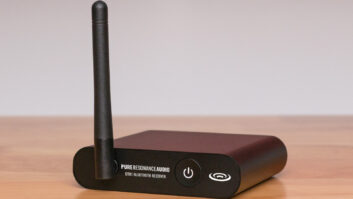
The history of the ADR Compex Limiter F760X RS goes back to the late ’60s in England when Audio & Design Recording made the single-knob F600 compressor module. It used a diode bridge gain changing circuit and had fixed attack and release times. Later on, the single-channel F760X-N compressor module used an FET gain cell, had variable attack, release and ratio controls, and also included a peak limiter and expander/gate. In 1973, ADR came out with a stand-alone three-rackspace, 2-channel version that was subsequently repackaged into a two-rackspace unit and badged as the Compex Limiter F760X-RS.
The reissued F760X-RS, made by Q2 Audio in the U.S., is built in an all-steel two-rackspace cabinet with an internal linear world power supply and maintains exactly the same design, sound and many of the operational quirks as the 2-channel models sold in 1980. Modern updates include component upgrades that address reliability and long-term gain-staging stability—issues that plagued the original units. Changes include rear panel TRS sidechain jacks for either the compressor or the gate via an internal jumper, an input/output transformer option, and faster Simpson 2121 gain reduction meters.
Variloss FET-Controlled Amplifier
The Compex’s compressor, limiter and expander/gate sections each produce independent control voltages that are scaled and summed together and then applied to a single, “variloss” FET-controlled amplifier gain cell. The inherent fidelity loss, noise buildup and interaction problems when chaining together separate analog processors is avoided by using a common gain changing cell.
There are 18 control knobs and 12 toggle switches on the Compex’s front panel. Exactly the same as the original units from the psychedelic ’60s, the control knobs have yellow collar pointers and are color-coded by function. The front-panel silk screening is color-coded by processor section, although it does not make reading them easier, especially the green color used on the Expander/Gate section.
There are separate in/out bypass switches and input and output trim controls for channels 1 and 2. The master stereo input and output pots control in/out levels for both channels at the same time. The two channels’ compressor and expander/gate sections can be stereo-coupled; however, the limiter section always remains independent. The manual states, “Momentary attenuation of transients will not be appreciably noticeable with regard to image shift.”
The limiter has a fixed 250μs attack time, 250ms release and a ratio of 100:1. The Pre.Emp position toggles in a passive, high-frequency boost circuit into the limiter’s sidechain. A holdover from the original unit’s use in broadcast audio chains, Pre.Emp mode tends to flatten out the transmitter’s fixed 50μs pre-emphasis curve (by limiting more in the high frequencies) to achieve full modulation without over-modulating the high frequencies. In the recording studio, Pre.Emp mode can function as a subtle de-essser.
Two red LEDs (one for each channel) flash instantaneously whenever the limiter threshold is crossed as determined by the input level control(s); the limiter threshold can be anywhere below and up to +14 dBu. The unit’s maximum output level is +18 dBu. The Jensen input and output transformer option allows for +22dBu maximum output and fully balanced I/O operation.

The back panel of the F760X-RS includes XLR in/outs and ¼-inch sidechain inputs.
The Compex’s compressor is a soft-knee type with a toggle switch for three attack time choices: 2.5 ms, 25 ms and super-fast 250 μs. A gold-plated Elma rotary switch selects among nine different release times between 25 ms and 3.2 seconds, plus Auto—a two-stage program-dependent release. Rotary switches are used for setting both Threshold—ranging from -20 dB to 0 dB in 11 steps and Ratio between 1:1, 2:1, 3:1, 5:1, 10:1 and 20:1.
The expander/gate section has three attack time choices: 2 ms, 40 ms and 20 μs. Expansion ratio is fixed at 1:2. Release time is a pot labeled F for fast to S for slow, while the expansion Range control varies from 20 dB to 0 dB. The Threshold knob goes from Hi (or least sensitive) to Lo. A toggle switch changes this section between off, expansion or gate when the ratio goes to 1:20. Two green LEDs (one for each channel) flash when the expander/gate is operating.
The poorly written, terse manual has a procedure for the unit’s initial setup and calibration that should be followed. I used a 1kHz tone to verify that both channels were identically matched and passing audio at unity without any processing switched in. Unlike the limiter and expander/gate, the compressor has no bypass switch, so I set its ratio to 1:1. I also initially set the compressor’s release to Auto; the best working auto release I’ve ever used—it is very fast during the initial recovery of 5dB of gain reduction then slows down after that—brilliant especially for the massive and deep compression effects possible with the Compex.
Let There Be Drums!
In Pro Tools I used hardware insert paths with delay compensation to route an in-the-box mix of 20 tracks of recorded drums to and from the Compex. I re-balanced the kit with more emphasis on the ambient room mics and overheads.
The stereo master input knob should start at about midway with the individual input trim controls wide open and the stereo master output knob nearly fully up, assuming proper input levels coming to and from your Pro Tools I/O; mine are standard calibration at -18 dB. Once I started lowering the threshold of the compressors and advancing the input level, the meters were deflecting between 8 and 16dB of gain reduction with the red limiter LEDs lighting up on every snare and kick hit. With the meters deflecting and the flashing red and green LEDS (if you are also expanding), you’ll have quite a light show in your outboard rack.
The unlit Simpson meters stay at full-scale reading 0 dB, deflecting only with gain reduction and/or expander/gate action. But they are hard to see in dark control rooms and do not have input/output source switching.
Compressor ratios can be from 2:1 to 5:1 for variation but this sound is all about the compressor’s threshold setting—I had it set anywhere from -4 to -18 dB. During extreme limiting, the Pre.Emp mode caused more gain reduction for cymbal crashes but would “punch” holes in the overall sound with each kick drum hit if I wanted.
Compressor attack and release time settings are very important. I tried many release time settings but I kept coming back to Auto for this application. Attack time was either the 25ms or 2.5ms, which kept the drums bright without stealing too much of their thunder and making them small-sounding. The resultant drum sound is punchy, dense and violent.
I found the Compex capable of many different variations of snare drum smashing. On the snare track of the same kit, it was easy to dial in impressive-sounding gated snare effects and parallel processing. The settings remained very stable for a ’60s vintage analog design.
Setting the compressor and gate together can be a bit of a juggling act, but having preset attack time switches for both is a great idea! It allowed me to experiment trading off between gate and compressor attack times easily and quickly. I used the 2.5ms attack on the compressor and the 250μs attack time on the gate for snare drum gating effects.
Pianos, Synths and Vocals
Sometimes, I found that using the expander/gate in expand mode yielded a smoother and more musical fade of sustaining chords while also suppressing leakage. Here, the meters are useful for “visualizing” and setting expander/gate release timing precisely.
A stereo grand piano takes on a decidedly rock sound as the Compex is not a super-clean and transparent dynamics processor—it will add a grainy texture to harmonically rich sources like pianos. I used a 2:1 or 3:1 ratio, 25ms attack with the limiter either off or set so the LEDs only occasionally lit; this kept the sound bright and the level consistent within a guitar heavy track. I used the expander set to a low threshold and medium-fast release. I always left the Range control set to 20 dB.
A dynamically out-of-control Minimoog solo became a mixing nightmare to get it to “lay in” at a steady and hearable level. I set the Compex to 5:1 ratio and either Auto or 3.2-second release time with slowest attack. This worked like a leveling amp where the signal is under constant gain reduction, removing all dynamics and making it even. This colorful-sounding “brute force” dynamic wrangling also fixed an unruly guitar track.
I used the Compex on a stereo lead vocal stem, six tracks that included doubles, harmony tracks and all effect returns. I wanted a cohesive sound and used a 3:1 ratio, high threshold and slow attack on the compressor. To hush six tracks of headphone spill in between words and phrases, I used the gate set to: slowest attack time, fast release, threshold set midway, and 20dB range. With a high threshold set for the compressor section, I could simply turn up the stereo input control to add more limiting. The Compex scores big here with an “in your face” vocal sound that no backing track can cover up.
An Engineer’s Processor
The F760X-RS is an advanced analog processor that will increase apparent loudness/record audio levels yet provide reliable overload protection. Successful use of the Compex Limiter demands a deep understanding of dynamic processing and its signal chain operation. Compex processing is addictive: the more compression/limiting I heaped on revealed the unit’s true personality as an aggressive and colorful-sounding FET-based limiter/compressor. After getting used to its quirks, I found its time-proven design along with modern updating made it irresistible. I highly recommend it.
Barry Rudolph is an L.A.-based recording engineer. Visit him at www.barryrudolph.com.
Product Summary
COMPANY: Audio Design Recording
PRODUCT: Compex Limiter F760X-RS Reissue by Q2 Audio
WEBSITE:www.q2audio.com
PRICE: $2,750; transformer option $400
PROS: Awesome and colorful ’60s processor updated for modern times.
CONS: Hard to read front panel silkscreen; meters need lights.
Try This
You can use the Compex Limiter F760X-RS as a parallel processor by sending the same audio signal to both channels at the same time and processing each in a different way, and then playing each channel out on separate faders in your DAW mixer. This works great for snare, kicks, lead vocals and synths.







